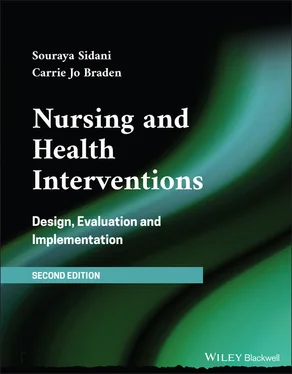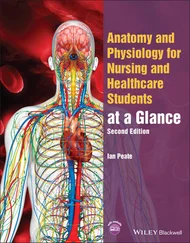3.3.1 Theoretical Approach
3.3.1.1 Overview
The theoretical approach relies on relevant theories to develop an understanding of the health problem requiring intervention. Middle range theories are most useful because they describe the health problem and explain its associations with determinants, within a particular context (Moore & Evans, 2017).
Theories consist of a group of statements, based on careful reasoning and/or evidence that present a systematic and logical view of the health problem. The statements are logically organized to identify, define, and describe the problem and its determinants, and to explain the direct and indirect relationships among the determinants and the problem. The explanations clarify conceptually why and how the relationships come about, that is, what goes on that connects each determinant to the problem. For example, the following pathway explains the association between age and insomnia: As individuals age, they spend more time in light, than deep, stages of sleep; they are prone to arousability resulting in frequent awakenings during the night, manifested in difficulty maintaining sleep.
A direct relationship reflects an immediate linkage between a determinant and the problem, where the problem flows straightforwardly from or is a function of the determinant. For example, there is a direct association between caffeine and nicotine intake close to bedtime and insomnia; caffeine and nicotine are stimulants that interfere with sleep.
An indirect relationship can take either of two forms: mediated or moderated. The relationship between a determinant and the health problem is considered mediated when another factor intervenes between the two, whereby the determinant influences the mediator (also called intervening factor), which in turn affects the health problem (MacKinnon & Fairchild, 2009). For example, cognitions are erroneous beliefs, resulting from worry or rumination about sleep‐related issues such as inability to get eight hours of sleep and the negative impact of insomnia on daytime functions. These cognitions increase arousal and drive engagement in sleep behaviors in an attempt to alleviate arousal; however, these behaviors may be ineffective and the repeated experience of arousal in bed results in conditional arousal (i.e. associating the bed with wakefulness), which contributes to insomnia (Schwartz & Carney, 2012). The relationship between a determinant and the health problem is characterized as moderated when it is affected by another factor (also called moderator). The moderator is the condition (e.g. personal or environmental feature) under which the relationship exists, that is, the presence, strength or magnitude, and/or direction of the relationship between the determinant and the health problem vary according to the value of the moderator (Fleury & Sidani, 2018). For instance, gender could moderate the association between arousal and insomnia; women may experience life stress (because of multiple roles' demands) and worry, which is likely to strengthen the relationship between arousal and insomnia if not well managed.
A wide range of middle range theories are available and have been used to generate an understanding of health problems. Theories that have commonly informed the understanding of the occurrence of health behaviors (e.g. physical inactivity, diet, medication adherence) include the health beliefs model, the transtheoretical model, social cognitive theory, social ecological model, and theory of planned behavior (Beall et al., 2014; Durks et al.m 2017; Fassier et al., 2019; Glanz & Bishop, 2010; Lamort‐Bouché et al., 2018). Other theories include self‐determination theory and self‐regulation theory (e.g. Muellmann et al., 2019). Cognitive theories have been used to understand some psychological health problems such as depression (Vittengl et al., 2014) and insomnia (Harvey et al., 2007). Kwasnicka et al. (2016) reviewed theories that explain how behaviors are maintained.
Different middle range theories propose different conceptualizations of the same health problem. The theories identify different sets of determinants, operating at different levels and/or related to the health problem through different pathways or mechanisms. Selection of a theory or theories should take into consideration the complexity of the real world (i.e. multiple factors, at different levels, contribute to the health problem). Attending to complexity demands the careful review, appraisal, and, if necessary, integration of different theories (or elements of theories) to explain the health problem as experienced by the target client population within the respective context (Bleijenberg et al., 2018; Moore & Evans, 2017). For example, conceptualizing insomnia from a behavioral perspective alone may not be adequate, as it is recognized that behaviors are shaped by cognitions (i.e. beliefs), attitudes, personal sense of control, sociocultural norms, and physical environment (Dohnke et al., 2018). Therefore, the selection of middle range theories to generate the theory of the health problem should be carefully done.
To be useful in understanding the health problem, middle range theories need to be relevant to the problem of interest. This necessitates a clarification of the problem, identification of available theories, and critical analysis of the theories' description of the problem and propositions regarding its determinants.
Step 1 – Clarification of the Problem
Clarification of the health problem entails an initial delineation of its nature. This is done by addressing the questions: What is the problem exactly about? Is it an actual or potential problem? How is the problem manifested? In what domain of health is it experienced, in what way, by whom, in what context, at what time? Is the concern about the occurrence or the maintenance of the problem? Answers to these questions generate a clear definition of the problem and specification of its attributes, experienced by a particular client population, in a particular context. For example health behaviors are described relative to target, action, context, time, and actors (Aráujo‐Soares et al., 2018). The clarification of the problem guides the search for relevant theories; it provides key terms and sets limits (e.g. client population, context) for conducting the search.
Step 2 – Identification of Theories
Two general methods can be used to identify relevant theories that explain the health problem as defined in Step 1. The first method relies on consultation with scholars and/or health professionals who have expert theoretical and/or clinical knowledge of the health problem. They may have developed, adapted, or been aware of relevant theories. The second method consists of a literature search . The search covers a wide range of sources including: theoretical or conceptual papers that focus on the presentation of the theory or its adaptation to a particular client population or context; textbooks or chapters that describe the health problem from a theoretical or clinical perspective; and grey literature such as professional organizations' websites providing access to white papers or conference presentations about the problem and relevant theories. The search may be extended to empirical papers reporting on studies that tested the theories in different client populations and contexts. Literature sources are selected if they offer a clear description of the theory, which contains a definition of the health problem, identification of its determinants, and propositions explaining the relationships (direct and indirect) between the determinants and the problem.
Читать дальше












